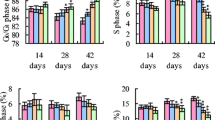Abstract
The experiment was conducted with the objective of examining the effects of high molybdenum (Mo) on the apoptosis of splenic lymphocytes in broilers by the methods of experimental pathology and flow cytometry (FCM). Three hundred 1-day-old avian broilers were divided into four groups of 75 each and were fed on control diet (Mo 13 mg/kg) and high Mo diets (Mo 500 mg/kg, high Mo group I; Mo 1,000 mg/kg, high Mo group II; and Mo 1,500 mg/kg, high Mo group III) for 42 days. The results showed that the relative weight of spleen was decreased, and lymphocytes were histopathologically decreased in high Mo groups II and III. Ultrastructurally, the apoptotic cells showed typical condensed nuclei with dark-round, petal-like, and horseshoe-like shapes. The mitochondria were swelled, and the endoplasmic reticulum and the Golgi apparatus were dilated in high Mo groups II and III. The statistical analyses by FCM indicated that the percentage of cellular apoptosis was higher in high Mo groups II and III than in control group. Also, the TUNEL staining was consistent with the results of FCM. It was concluded that dietary molybdenum in 1,000 and 1,500 mg/kg caused splenic lesions and lymphocyte apoptosis, which could inhibit the development of spleen and could impair immune function in broilers.





Similar content being viewed by others
References
Richert DA, Westerfield WW (1953) Isolation and identification of the xanthine oxidase factor as molybdenum. J Biol Chem 203:915–923
Klaassen CD (2002) Casarett and Doull's toxicology: the basic science of poisons. McGraw-Hill. 844–845
Bersényi A, Berta E, Kádár I, Glávits R, Szilágyi M, Fekete SG (2008) Effects of high dietary molybdenum in rabbits. Acta Vet Hung 56(1):41–55
Ferguson WS, Lewis AH, Watson SJ (1938) Action of molybdenum in nutrition of milking cattle. Nature 141:553
Barceloux DG, Barceloux D (1999) Molybdenum. Clin Toxicol 37(2):231–237
Seldén AI, Berg NP, Söderbergh A, Bergström BEO (2005) Occupational molybdenum exposure and a gouty electrician. Occup Med 55:145–148
Lener J, Bibr B (1984) Effects of molybdenum on the organism. J Hyg Epidemiol Microbiol Immunol 4:405–419
Ostrom CA, Van Reen R, Miller CW (1961) Changes in the connective tissue of rats fed toxic diets containing molybdenum salts. J Dent Res 40:520–527
Peng X, Cui Y, Cui W, Deng J, Cui H (2009) The decrease of relative weight, lesions, and apoptosis of bursa of fabricius induced by excess dietary selenium in chickens. Biol Trace Elem Res 131(1):33–42
Roset R, Ortet L, Gil-Gomez G (2007) Role of Bcl-2 family members on apoptosis: what we have learned from knock-out mice. Front Biosci 12(20):4722–4730
Palmer AM, Greengrass PM, Cavali AD (2000) The role of mitochondria in apoptosis. Drug News Perspect 13(6):378–384
Raisbeck MF, Siemion RS, Smith MA (2006) Modest copper supplementation blocks molybdenosis in cattle. J Vet Diagn Invest 18:566–572
Zamzami N, Marchetti P, Castedo M (1995) Reduction in mitochondrial potential constitutes an early irreversible step of programmed lymphocyte death in vivo. J Exp Med 181:161
Suttle NF (1991) The interactions between copper, molybdenum, and sulphur in ruminant nutrition. Annu Rev Nutr 11:121–140
Hansen SL, Schlegel P, Legleiter LR, Lloyd KE, Spears JW (2008) Bioavailability of copper from copper glycinate in steers fed high dietary sulfur and molybdenum. J Anim Sci 86(1):173–179
Ward JD, Gengelbach GP, Spears JW (1997) The effects of copper deficiency with or without high dietary iron or molybdenum on immune function of cattle. J Anim Sci 75:1400–1408
Arthington JD, Corah LR, Blecha F (1996) The effect of molybdenum-induced copper deficiency on acute-phase protein concentrations, superoxide dismutase activity, leukocyte numbers, and lymphocyte proliferation in beef heifers inoculated with bovine herpesvirus-1. J Anim Sci 74:211–217
Galbraith H, Chigwada W, Scaife JR, Humphrise WR (1997) The effect of dietary molybdenum supplementation on tissue copper concentrations, mohair fibre and carcass characteristics of growing Angora goats. Anim Feed Sci Technol 67:83–90
Ladefoged O, Stürup S (1995) Copper deficiency in cattle, sheep and horses caused by excess molybdenum from fly ash: a case report [J]. Vet Hum Toxicol 37:63–65
Gray LF, Daniel LJ (1964) Effect of the copper status of the rat on the copper–molybdenum–sulfate interaction. J Nutr 84:31–37
Fungwe TV, Budding F, Demick DS, Lox CD, Yang MT, Yang SP (1990) The role of dietary molybdenum on estrus activity, fertility, reproduction and molybdenum and copper enzyme activities of female rats. Nutr Res 10:515–524
Acknowledgement
The study was supported by Program for Changjiang Scholars and Innovative Research Team in University (IRT 0848) and Education Department and Scientific Department of Sichuan Province (2006A007).
Author information
Authors and Affiliations
Corresponding author
Rights and permissions
About this article
Cite this article
Yang, F., Cui, H., Xiao, J. et al. Increased Apoptotic Lymphocyte Population in the Spleen of Young Chickens Fed on Diets High in Molybdenum. Biol Trace Elem Res 140, 308–316 (2011). https://doi.org/10.1007/s12011-010-8697-y
Received:
Accepted:
Published:
Issue Date:
DOI: https://doi.org/10.1007/s12011-010-8697-y




